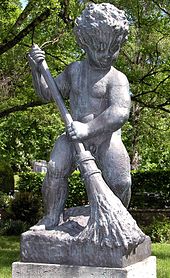Jakob Hofmann



Jakob Hofmann (born December 17, 1876 in Aschaffenburg , † June 26, 1955 in Braunschweig ) was a German sculptor and draftsman .
Education and early creative years
As the son of a carpenter , Hofmann first completed an apprenticeship as a stonemason and then studied from 1895 to 1897 at the Royal School of Applied Arts in Munich and from 1897 to 1908 at the Academy of Fine Arts in Munich , with Wilhelm von Rümann and Adolf von Hildebrand among his teachers. During this time he designed a fountain for Ansbach , a war memorial for his hometown and several sculptures for the Kurhaus in Wiesbaden . After receiving several awards, he traveled to Paris and Italy in 1908 to study . After his return he created numerous works in Munich before he took over his father's business in Aschaffenburg.
Creative time in Braunschweig
In 1913 Hofmann succeeded Carl Echtermeier at the chair for life drawing and modeling at the Technical University of Braunschweig , which he held until 1945. In 1915/16 Hofmann participated in the war . In the years 1915 to 1922 he exhibited as a member of the Munich Secession in the Glaspalast and at the Berlin Secession exhibitions .
From 1920 to 1933 Hofmann was a member of the Braunschweiger Zehnerbundes visual artists , founded in 1920, and exhibited with it. In addition to numerous grave monuments, portrait busts and statues, Hofmann also created the masks for the public library in Braunschweig, as well as the memorials for the 70th and 92nd Infantry Regiments and a Pietà for the Katharinenkirche .
For in 1925 revealed and Flesche Herman designed colonial monument in Braunschweig city park, which is a reminder of the lost by the war German colonies and the fallen there soldiers, he created the sculpture of a lion holding the globe with his paws.
In 1928, a bronze Siegfried fountain followed for the Siegfriedviertel settlement in Braunschweig, which was founded in 1919 . This statue was melted down during World War II and only poured again in 1988 and then put back in its original location, Burgundenplatz.
Activity during the time of National Socialism
After the National Socialists came to power , Hofmann took part in the exhibition of the Reich Cartel in 1933, in 1934 and 1935 he had solo exhibitions in the Herzog Anton Ulrich Museum , between 1935 and 1943 he was involved in exhibitions of the Braunschweiger Künstlerbund and in 1938 in that of the relief organization for German visual arts Art (the NSV ).
In 1936 Hofmann renewed the weathered figures of the Braunschweiger Gewandhaus . In addition, in 1938 he created the Braunschweiger “ Besenmännchen ”, which served as a symbol for the renovation of the old town , which Herman Flesche had begun in 1932 and which the National Socialists began in 1933 in Braunschweiger Neustadt . The aim of the old town renovation was to create improved sanitary and hygienic living conditions. In 1943 and 1944 he took part in the Gau art exhibitions in Braunschweig.
Art Prize of the City of Braunschweig
On December 12, 1943, Hofmann was the last artist to receive the Art Prize of the City of Braunschweig, which was only launched in 1941 . In the laudation it was emphasized that Hofmann had never allowed himself to be influenced by the trends of the time, that his “broom man” was a household name and that his oeuvre had “high artistic creativity” .
post war period
On December 23, 1951, a bust created by Hofmann of the SPD politician and multiple Braunschweig Prime Minister Heinrich Jasper was unveiled. It is located on the west side of the Braunschweig district government building , on Ruhfäutchenplatz.
In Hofmann's honor, the city of Braunschweig named a path in the northern ring area, near Löbbeckes Insel, after him.
supporting documents
- ↑ Braunschweig Municipal Museum and Braunschweig University of Fine Arts (ed.): German Art 1933–1945 in Braunschweig. Art under National Socialism. Catalog of the exhibition from April 16, 2000 - July 2, 2000. Braunschweig 2000; P. 202.
- ↑ Braunschweig Municipal Museum and Braunschweig University of Fine Arts (ed.): German Art 1933-1945 in Braunschweig. Art under National Socialism. Catalog of the exhibition from April 16, 2000 - July 2, 2000. Braunschweig 2000; P. 69.
literature
- Herman Flesche : Jakob Hofmann. in: Aschaffenburg yearbook. 1956, pp. 421-424.
- Horst-Rüdiger Jarck , Günter Scheel (Ed.): Braunschweigisches Biographisches Lexikon - 19th and 20th centuries . Hahnsche Buchhandlung, Hannover 1996, ISBN 3-7752-5838-8 .
- Braunschweig Municipal Museum and University of Fine Arts (ed.): German Art 1933–1945 in Braunschweig. Art under National Socialism. Catalog of the exhibition from April 16, 2000 to July 2, 2000, Georg Olms Verlag, Hildesheim 2000, ISBN 3-487-10914-X .
Web links
| personal data | |
|---|---|
| SURNAME | Hofmann, Jakob |
| BRIEF DESCRIPTION | German sculptor and draftsman |
| DATE OF BIRTH | December 17, 1876 |
| PLACE OF BIRTH | Aschaffenburg |
| DATE OF DEATH | June 26, 1955 |
| Place of death | Braunschweig |
